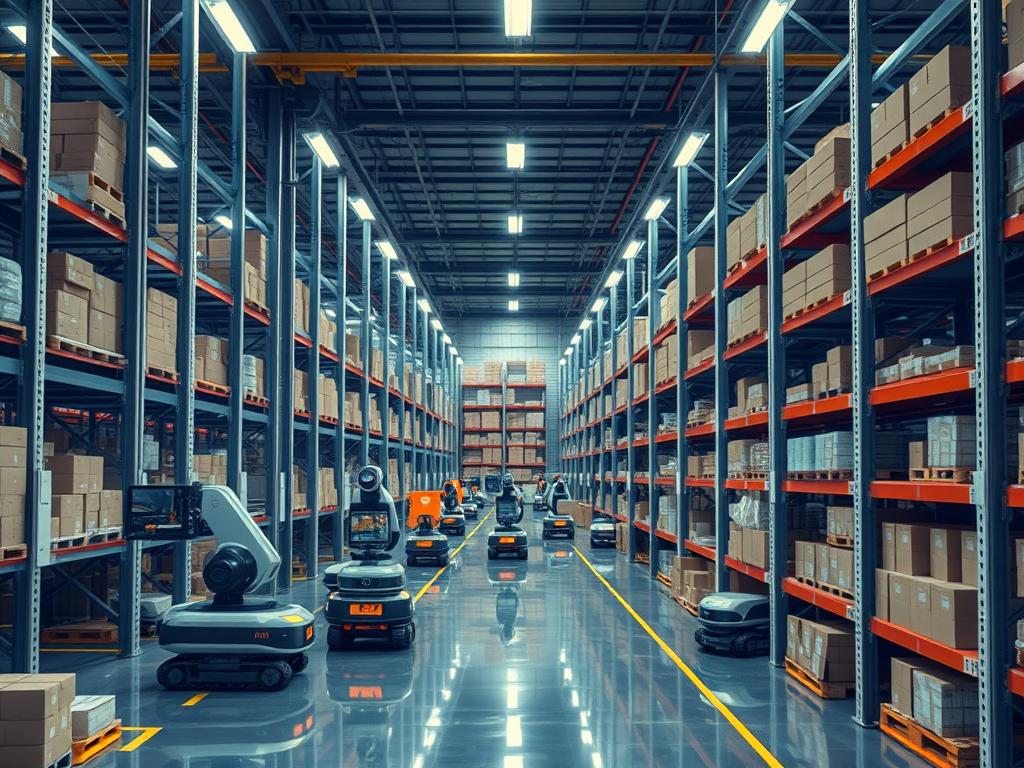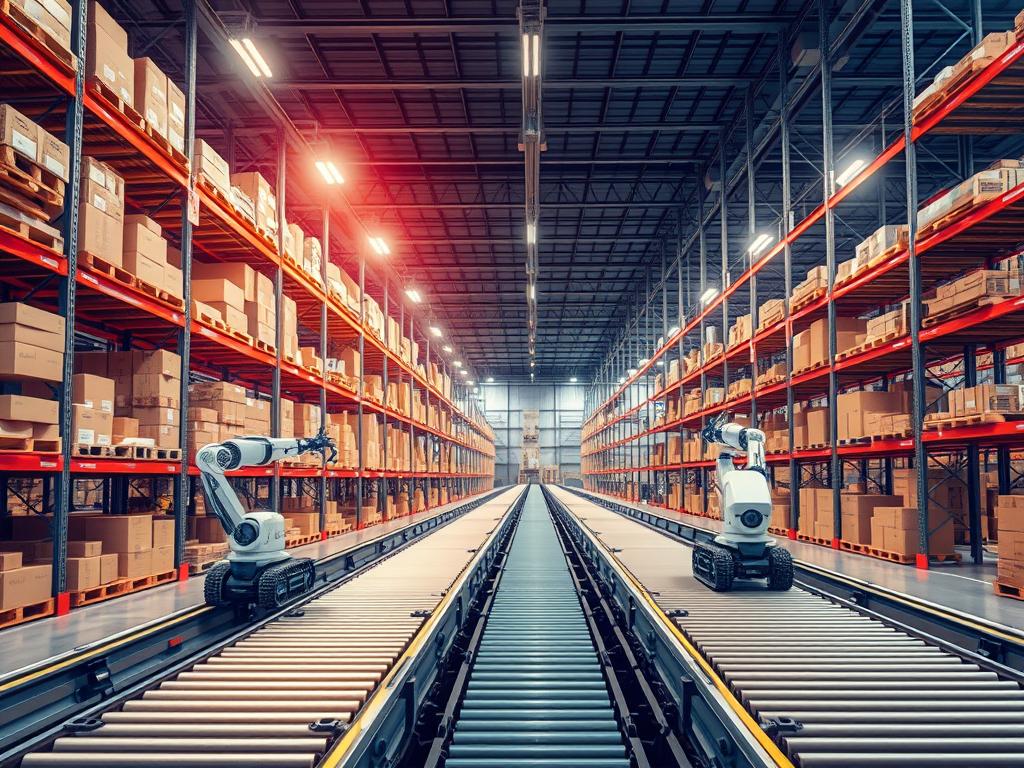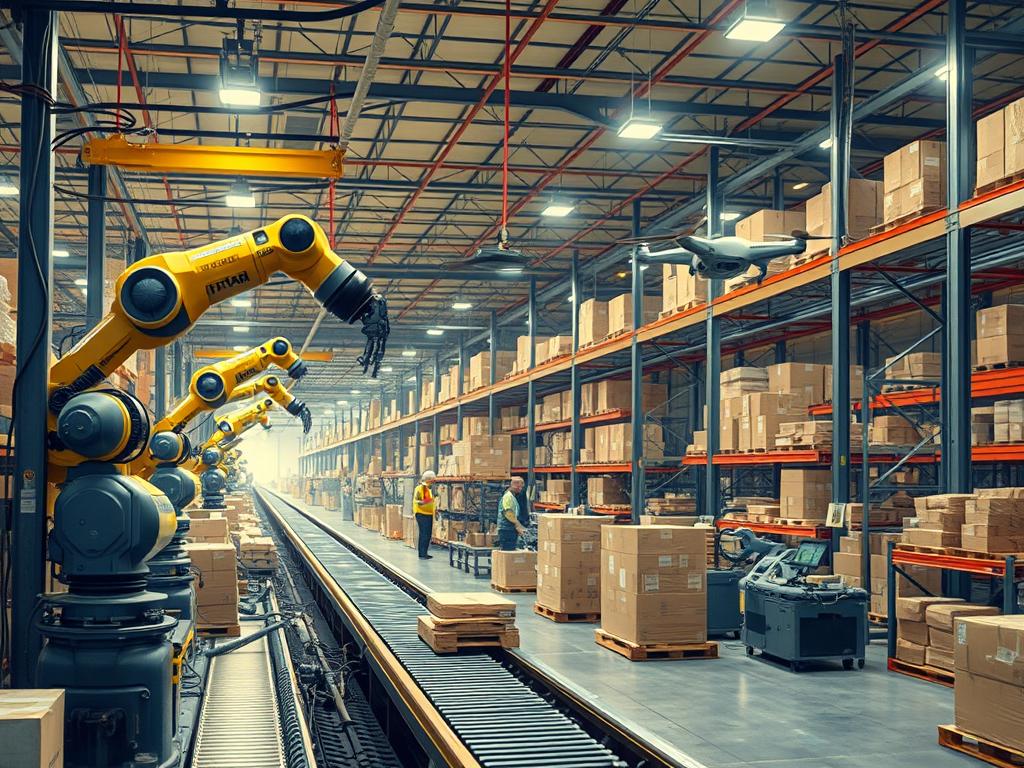Labor costs make up 50% to 70% of warehousing budgets. This highlights the need for innovative solutions in logistics. Warehouse automation is changing how we store, manage, and distribute goods.
Robotic processing and intelligent automation are creating a digital workforce. These technologies are improving efficiency and cutting costs in modern warehouses.
Automation greatly impacts warehouse operations. It can boost productivity by 25% and stock use efficiency by 30%. Automated systems can achieve 99.99% picking accuracy.
Over 60% of companies plan to invest in conveyor and sortation systems. This shows the growing importance of automation in logistics.
The future of logistics is unfolding now. Autonomous mobile robots and advanced warehouse management systems are leading the charge.
These innovations are not just improving efficiency. They’re reshaping the entire industry landscape.
Understanding Robotic Process Automation in Warehousing
Robotic Process Automation (RPA) is revolutionizing warehousing. This technology makes warehouses faster and smarter. Let’s explore RPA and its importance.
What is Robotic Process Automation?
RPA uses smart software robots for repetitive tasks. These process automation tools work non-stop, without breaks. They don’t need complex coding, making them business-friendly.
RPA bots can integrate with existing systems easily. This means no major IT changes are needed.
Key Benefits of Robotic Process Automation
RPA offers several advantages for warehouses:
- Cuts down on mistakes
- Speeds up order processing
- Keeps inventory up-to-date in real-time
- Makes better use of warehouse space
- Lowers labor costs
With RPA, warehouses handle more products faster and more accurately. This helps meet the growing demands of online shopping.
It also tackles complex logistics challenges effectively.
Real-World Applications in Warehousing
RPA is making real changes in warehouses today. Here are some examples:
| Application | Impact |
|---|---|
| Inventory Management | Real-time updates, prevents overstocking |
| Order Processing | Faster fulfillment, happier customers |
| Picking and Packing | Quicker, more accurate order assembly |
| Shipment Tracking | Timely updates, better customer service |
Bot automation in these areas improves warehouse operations. It leads to smoother processes and better customer service.

RPA is the secret weapon for warehouses looking to stay ahead in today’s fast-paced market.
Advanced Technologies Transforming Logistics
The logistics industry is experiencing a tech revolution. Cognitive automation and AI-powered solutions are reshaping warehouse operations. These advancements boost efficiency, accuracy, and sustainability in supply chains.
The Role of Artificial Intelligence and Machine Learning
AI and machine learning are transforming logistics operations. They enable predictive analytics, demand forecasting, and route optimization. Companies using AI-powered automation enhance operational performance and reduce their carbon footprint.
The logistics automation market is thriving. It was valued at $30.90 billion in 2022. Experts project a CAGR of 14.3% for this sector.
Integration of Internet of Things (IoT) in Warehousing
IoT devices are revolutionizing warehouse management. Sensors and RFID tags provide real-time data on product movement. This integration improves inventory control and operational efficiency.
Edge computing enables instant decision-making for autonomous robots and IoT devices. It creates smart, interconnected warehouse systems that adapt quickly.
Utilizing Drones for Inventory Management
Drones are changing inventory management practices. They offer rapid and accurate stock counts in large warehouses. This tech, combined with cognitive automation, creates an adaptive virtual workforce.
Drones improve overall supply chain performance. They also reduce manual errors in inventory tracking.
| Technology | Application | Benefit |
|---|---|---|
| AI and Machine Learning | Predictive analytics, demand forecasting | Enhanced operational performance |
| IoT | Real-time product tracking | Improved inventory control |
| Drones | Rapid stock counts | Increased accuracy in inventory management |
Companies investing in these technologies are ready for future challenges. AI-powered automation, IoT, and drones create efficient logistics ecosystems. They also promote sustainability, safety, and reliability in supply chains.
Case Studies: Successful Implementations of RPA
RPA has transformed warehouse operations across industries. Major companies use intelligent automation to boost their logistics and supply chain processes.
Amazon’s Robotics Strategy
Amazon leads in warehouse automation with over 200,000 mobile robots. This move has cut order processing times and boosted efficiency. Software robotics and physical automation help Amazon handle huge order volumes quickly and accurately.
Walmart’s Automated Inventory Systems
Walmart uses RPA to revamp its inventory management. AI-powered robots monitor and replenish stock, improving accuracy and efficiency. This system cuts manual labor and reduces stockouts and overstocking issues.
FedEx’s Use of RPA for Package Handling
FedEx integrates RPA into package sorting and tracking. This speeds up deliveries and reduces errors. Software robotics help FedEx process packages faster and provide real-time tracking to customers.

These cases show RPA’s power in logistics. Companies using intelligent automation see better efficiency, lower costs, and happier customers.
The global RPA market could hit $30.85 billion by 2030. It’s expected to grow 39.9% yearly from 2023 to 2030. This shows RPA’s rising importance across sectors.
| Company | RPA Implementation | Key Benefits |
|---|---|---|
| Amazon | 200,000+ mobile robots | Reduced order processing times |
| Walmart | AI-powered inventory robots | Improved stock accuracy and efficiency |
| FedEx | Automated package sorting and tracking | Enhanced delivery speed and reduced errors |
Overcoming Challenges in Warehouse Automation
Warehouse automation offers great benefits but comes with challenges. Companies face obstacles when implementing digital workforce solutions and RPA bots. Let’s explore these challenges and their solutions.
Common Barriers to Implementation
High automation costs can be a major roadblock. However, long-term benefits often outweigh initial expenses. Companies should calculate ROI, considering labor savings and efficiency gains.
Integration with existing systems can be complex. Careful planning and collaboration with providers offering seamless integration services is crucial.

Addressing Workforce Concerns
Employees often fear job loss due to bot automation. Companies should focus on upskilling and reskilling programs. This approach creates a more adaptable and skilled workforce.
Clear communication about automation’s benefits and its impact on job roles is essential. It helps alleviate employee concerns and fosters a positive work environment.
Ensuring Data Security and Privacy
As warehouses automate, data security becomes crucial. Robust cybersecurity measures are needed to protect sensitive information. Companies must invest in secure systems and train employees on data handling.
Implementing warehouse robotics requires a comprehensive approach to data protection. This ensures the safety of valuable business information.
| Challenge | Solution |
|---|---|
| High implementation costs | Calculate long-term ROI |
| Integration complexities | Partner with experienced providers |
| Workforce resistance | Offer upskilling programs |
| Data security risks | Implement robust cybersecurity measures |
Tackling these challenges head-on leads to successful warehouse automation. Companies can boost efficiency, accuracy, and competitiveness in modern logistics. The rewards are worth the effort.
Future Trends in Warehouse Automation
AI-powered automation is reshaping warehouse operations. Innovative tools are making processes more efficient and flexible. These advancements help meet the growing demands of e-commerce and global supply chains.
Vertical Integration and Automation
Warehouses are using vertical integration to maximize space. Goods-to-person robotics are replacing older automated systems. These new systems handle more product types and boost productivity.
Collaborative human-robot teams have shown to be 85% more effective than separate teams. This hybrid approach is becoming more popular in warehouses.
Sustainability in Robotic Automation
Warehouse automation is focusing on sustainability. AI optimizes energy use and reduces waste. Predictive maintenance cuts machine downtime by 30-40%.
This technology extends equipment life by 20-40%. It improves efficiency and makes operations more environmentally friendly.
The Impact of E-commerce Growth
E-commerce drives innovation in warehouse automation. Online shopping growth has increased investment in flexible solutions. The global warehouse automation market may reach $30 billion by 2026.
New tools handle complex e-commerce tasks. These include efficient order fulfillment and returns management.
| Automation Impact | Improvement |
|---|---|
| Inventory Accuracy | 76% (99% accuracy achieved) |
| Labor Cost Reduction | 36% (3% annually) |
| One-Day Shipping Consistency | 40% |
| Planned AI Investment | 42% of warehouses |
AI-powered automation will transform supply chain management by 2025. Dynamic demand forecasting and digital twins are changing the game. These tools help businesses adapt to market shifts quickly.
5G technology will boost warehouse connectivity. It will enhance data processing capabilities, making operations more efficient.
Frequently Asked Questions About Warehouse Automation
Warehouse automation is revolutionizing the logistics industry. This technology is transforming modern warehousing operations. Let’s explore some common questions about this innovative approach.
How does robotic process automation improve efficiency?
Robotic process automation (RPA) boosts warehouse efficiency by automating repetitive tasks. This virtual workforce reduces errors and increases processing speed. It also optimizes product storage for better organization.
Alibaba has automated 70% of its warehouse tasks, showing major productivity gains. RPA solutions like Automated Storage and Retrieval Systems can double warehouse productivity rates. These systems improve order completion speeds and inventory accuracy.
What industries can benefit from warehouse automation?
Warehouse automation offers advantages across many sectors. E-commerce giants like Amazon have transformed their operations through intelligent automation. Other benefiting industries include retail, manufacturing, automotive, and grocery/CPG.
Pharmaceutical and logistics sectors can also leverage automation for better efficiency. Each industry has unique needs but can optimize material flow and increase storage density. Overall operational efficiency improves with automation in these sectors.
Are there initial investment concerns with RPA?
The initial investment in RPA can be significant. However, the long-term benefits often outweigh the costs. Companies should consider scalability, integration capabilities, and customization potential when evaluating RPA solutions.
A self-assessment checklist can help choose the right automation solution. It’s important to account for demand variability and flexibility needs. Consider both indoor and outdoor automation potential.
Careful planning and phased approaches can maximize return on investment. This strategy helps businesses get the most from warehouse automation technologies.


